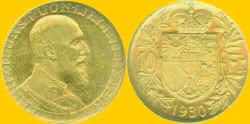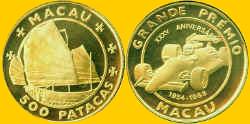This is the Worldwide Numismatics Website!
This is a modest collection of second millennium gold coins
Click the thumbnail picture to see a larger version of the picture, then use your browser BACK button to return to the original page you were viewing.
LIECHTENSTEIN
The Austrian Liechtenstein family acquired the fiefs of Vaduz and Schellenberg in 1699 and 1713 respectively, and they became an independent principality under the Holy Roman Empire in 1719 under the name Liechtenstein. The French under Napoleon came unasked and stayed for a few years, but Liechtenstein regained its independence in 1815 within the new German Confederation. In 1868, after the Confederation dissolved, Liechtenstein disbanded its army (of 80 men!) and declared its permanent neutrality, which was respected during both world wars. In 1919 Liechtenstein entrusted its external relations to neutral Switzerland. After WWII, Liechtenstein became increasingly important as a financial centre, and the country became more prosperous
Liechtenstein's coins are minted at Vienna and Bern mints.
10 Franken - 1930
Y-11 -
3.23 g
Mintage - 2.500
This coin has the bust of Prince Franz I on the
obverse with the German legend FRANZ - I - FURST-UOM-LIECHTENSTEIN with the
designer's name L.AUYER beneath the bust/ and the denomination.
The reverse the arms armorial flanked by the denomination 10 Fr. with the
date 1930 below. Liechtenstein is a
very small country between Austria and Switzerland and it has a special
arrangement with the latter.
There are more Liechtenstein gold coins in this section if you are interested - Page Liechtenstein 1
LUXEMBOURG
Though the area's occupation actually extends back further than the Roman era, present-day Luxembourg stems from the loins of Count Sigefroid of Ardennes, who raised a castle here in 963 AD and sowed the seeds of a dynasty that's spawned rulers throughout Europe. By the end of the Middle Ages, Sigefroid's city had the Burgundians, Spanish, French, Austrians and Prussians all waging bloody battles to conquer and secure it. Besieged, destroyed and rebuilt more than 20 times in 400 years, it grew to become the strongest fortress in Europe after Gibraltar. Listed as a French 'forestry department' during Napoleon's reign, Luxembourg was included in the newly formed United Kingdom of the Netherlands, along with Belgium, in 1814. It fragmented 16 years later, when Belgium broke off from the Netherlands, taking half of Luxembourg along for the ride. This division heated up the Grand Duchy's desire for independence, and in 1830 the Dutch portion became present-day Luxembourg. The 1867 Treaty of London reaffirmed this autonomy. Soon after, the country declared itself neutral in international affairs and - an appropriate symbol of its nascent neutrality - torched its much contested fort.
20 Francs - 1953
KM-M001
- 6,45 g
Mintage - 0,026M
This is a commemorative medal issued
commemorate the marriage of Princess Josephine Charlotte (b1927) and Grand Duke
Jean (b1921). The obverse has a
crowned crest for Grand Duke Jean surrounded by the countries name in French and
the marriage date below (9 April 1955). The
reverse has the conjoined busts of the royal couple with their names in French
and the designer's name below the busts. It bears no denomination but was struck
to the Latin Monetary Union standard equal to the French 20 Franc piece.
There are more Luxembourg gold coins in this section if you are interested - Page Luxembourg 1
MACAO
The former Portuguese colony's name is derived from the Ma Kwok temple, built there in the 14th cent. Macao was the oldest permanent European settlement in East Asia. It was a parched and desolate spot when the Portuguese established a trading post there in 1557. For nearly 300 years the Portuguese paid China an annual tribute for the use of the peninsula, but in 1849 Portugal proclaimed it a free port; this was confirmed by China in the Protocol of Lisbon in 1887. With the gradual silting up of its harbor and the rise (19th cent.) of Hong Kong, Macao lost its preeminent position and became identified to a large extent with smuggling and gambling interests. After 1949 the population was swelled by an influx of Chinese refugees from the mainland. In the winter of 1966–67, Communist-organized riots shook the province, resulting in a capitulation by the Portuguese to Chinese demands to bar entry to refugees and prohibit anti-Communist activities. In 1974, Macao was established as a Chinese territory under Portuguese administration; the Chinese refused to accept the return of the territory at the time. A real-estate boom in the early 1990s had largely waned by the end of the decade. Under the terms of a 1987 agreement, Macao became a special administrative region under Chinese sovereignty in December 1999. Macao has been promised 50 years of noninterference in its economic and social systems.
500 Patacas - 1988
KM-042
- 7,960 g
Mintage - 4.500
This NCLT "coin" was issued to commemorate the 35th anniversary of the Macao Grand Prix automobile race. The oberverse features a Chinese junk with MACAU at the top and the denomination 500 PATACAS. The reverse has a race car with GRANDE PREMIO MACAU encircling the racer. XXXV ANIVERSARIO 1964-1988 iswithin the circle.
MALAYSIA
Aboriginal Malays (Orang Asli) began moving down the Malay peninsula from south-western China about 10,000 years ago. The peninsula came under the rule of the Cambodian-based Funan, the Sumatran-based Srivijaya and the Java-based Majapahit empires, before the Chinese arrived in Melaka in 1405. Islam arrived in Melaka at about the same time and spread rapidly. Melaka's wealth soon attracted European powers, and the Portuguese took control in 1511, followed by the Dutch in 1641. The British established a thriving port in Penang in 1786 and took over Melaka in 1795. The British colonised the interior of the peninsula when tin was discovered. East Malaysia came into British hands via the adventurer Charles Brooke (who was made Rajah of Sarawak in 1841 after suppressing a revolt against the Sultan of Brunei) and the North Borneo Company (which administered Sabah from 1882). Britain took formal control of both Sabah and Sarawak after WWII. The indigenous labour supply was insufficient for the needs of the developing rubber and tin industries, so the British brought large numbers of Indians into the country, altering the peninsula's racial mix. The Japanese overran Malaya in WWII. Communist guerrillas, who fought the Japanese throughout the occupation, began an armed struggle against British rule in 1948 and Malaya achieved independence in 1957. Sabah, Sarawak and Singapore combined with Malaya to establish Malaysia in 1963, but two years later Singapore withdrew from the confederation.
20 Ringgit - 1976
KM-018
- 7,30 g
Mintage - 0,051M
This fourteen sided NCLT "coin" was issued to celebrate Malaysia's third Five Year Plan. The obverse features the arms of Malaysia with the legend RANCANGAN MALAYSIA KETIGA 1876-1980 and the denomination 200 RINGGIT below the arms. The finesness 900/1000 FINE GOLD and the FM mintmark (for the Franklin Mint, one of the notorious purveyors of NCLT) below the ribbon of he arms. The arms has a facing bust of the Prime Minister with his name TUN ABDUL RAZAK (b1922-d ) in the ribbon below. The flags of the Malaysia States surround his bust.
MALTA
The island's oldest legacy is the megalithic temples that date from as far back as 3800 BC. The Phoenicians colonised the islands around 800 BC and stayed for about 600 years. The Romans made Malta part of their empire in 208 BC. Apart from Ulysses' stay on Gozo (known as Calypso's Isle), the most famous visitor to the island was the apostle Paul, who was shipwrecked on Malta in 60 AD. Tradition has it that he converted the islanders to Christianity, although Biblical and scientific scholars now suggest he may have been wrecked on Kefallinía in Greece. Several hundred years of peaceful isolation followed, until Arabs from North Africa arrived in 870. The Arabs exerted a powerful influence on the Maltese, introducing citrus fruits and cotton and warping the language. Norman invaders from Sicily displaced the Arabs in 1090, and for the next 400 years Malta remained under Sicilian sway. In 1530 the Emperor of Spain gave the islands to the Knights of the Order of St John of Jerusalem, in exchange for a rent of two Maltese falcons a year. The Knights, formed during the Crusades, were a dumping ground for those younger members of the European aristocracy who didn't stand to inherit property. They fortified the islands - just in time for an invasion of 30,000 Turks in 1565. The Turks laid siege to Malta for three months, but 700 knights and 8000 Maltese managed to hold them off. The knights were hailed as the saviours of Europe. For their pains they were awarded a newly designed and fortified city, Valletta. With fame and power came corruption, and the knights turned to piracy. By the time Napoleon arrived in 1798, they were too enfeebled to put up a fight. It was the British who aided the Maltese in their fight against the French, and by 1814 Malta was a British colony. Britain turned Malta into a major naval base, making it an inviting target for the Axis during WWII. After a long blockade and five months of non-stop bombing raids, Malta was devastated. Soon after the war, Malta began moving away from Britain and toward independence, achieving complete autonomy in 1964.
£5 - 1972
KM-039 - 15,56 g - 19,2 mm
Edge - Reeded
Mintage
- 0,018M
The obverse has the arms of Malta with the country's name MALTA below. The reverse has a map of the islands with a compass rose and the year 1972 at the top right and the denomination £M5 at the lower left.
If you would like to see additional gold coins, please click here - Page 21
f you want to return to the home page, please click here - Home

